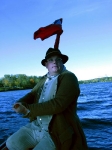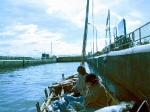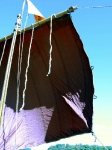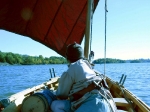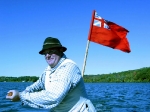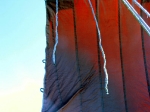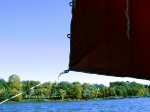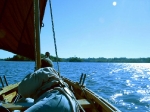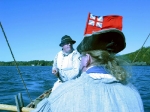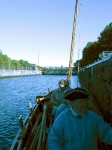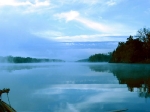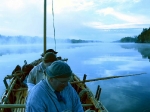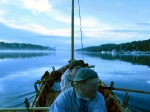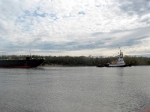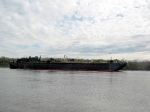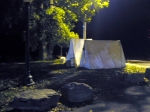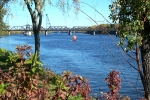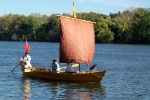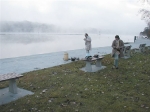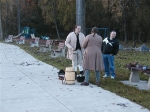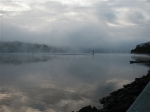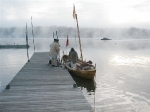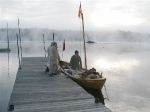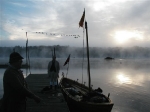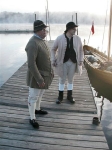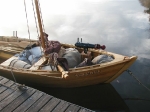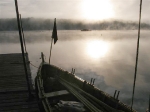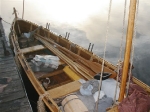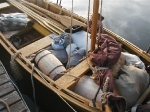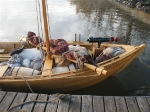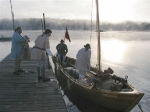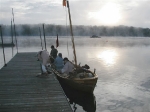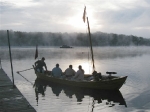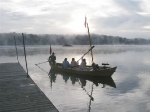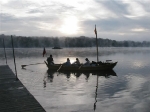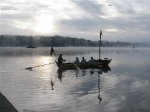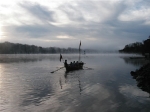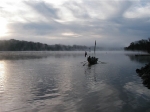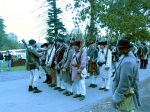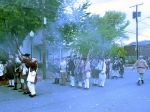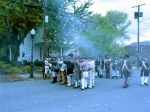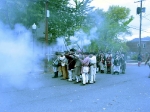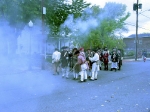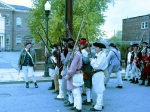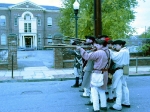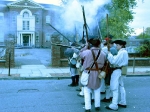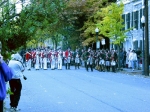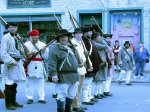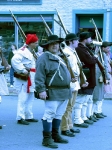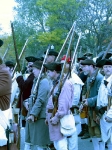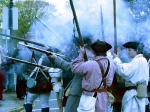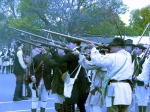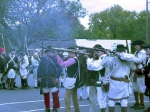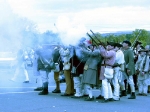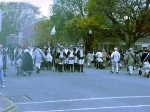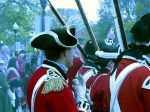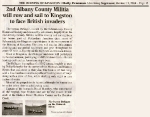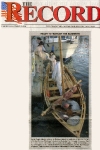Also known as ‘The Big Row, 2004’
by David Manthey, Bateau DeSager, Captain
The Trip – Overview
The bateau DeSager, owned by the Mabee Farm Historic Site and crewed by volunteers, largely from the 2nd Albany County Militia, was rowed and sailed from her home port of Rotterdam Junction, New York (just west of Schenectady), down to Kingston to participate in the reenactment of Burning of Kingston on the 227th anniversary of that event. The crew travelled and camped in 18th-century clothing and used period equipment and gear throughout the entire 92 mile trip. Once at Kingston, the DeSager and crew participated in the reenactment, portraying at different times a British landing craft and later an American armed boat.
The voyage started in Rotterdam Junction on Tuesday, 12 October 2004. We reached our intended camping spots each day, and stayed, in order, at the Waterford Terminal Wall, at Coeymans Landing town park, at Dutchman’s Landing village park in Catskill. We arrived successfully at the Hudson River Maritime Museum in Kingston. This involved travelling down 25 miles of the Mohawk River, 66 miles of the Hudson River, and up 1 mile of Rondout Creek. Although this was downstream, with the exception of Rondout Creek, we, at times, had to contend with contrary tides and winds.
The boat was returned to Rotterdam Junction via trailer.
Here is a map I made of the entire trip.
The Boat
The bateau DeSager is a replica of a 1792 bateau, similar to that used by Philip Schuyler for the survey of the Mohawk and Hudson Rivers done in that year. The design is similar to a scaled drawing of a bateau recorded by the British admiralty sometime between 1750 and the late 1770s. The boat is 23′ long, 5′ of beam, and is capable of hauling a ton of cargo along with a crew of 5 men. The boat is the size of an original Albany Boat, as would have been frequently used on the upper Hudson River or for small, express cargoes on the Mohawk River in the late 18th century.
The bateau is a flat-bottomed vessel, allowing it to have a very shallow draft. With a full crew, it only draws five or six inches of water. With a one-ton load, it would draw eight or nine inches of water. This shallow draft made the bateau an excellent river craft prior to the navigational improvements that were made on both Hudson and Mohawk Rivers.
The principal motive power of the bateau is oars. It is generally crewed by a steersman and from two to four rowers, though we have occasionally had as many as six rowers, and as few as one. With the right wind, the bateau can be sailed. Prior to this trip, it was believed that since the boat has no keel, centerboard, or lee boards, only a following wind could provide useful motive power. Historically, the bateau would have also been poled when in the shallows. As the modern Hudson and Mohawk Rivers have been deepened for navigation, poling is not a useful means of propulsion.
The bateau DeSager is owned by the Mabee Farm Historic Site, which is part of the Schenectady County Historical Society.
The boat is crewed by volunteers, mostly from the 2nd Albany County Militia / Schuyler’s Company of New York Provincials, which is a group dedicated to historical reenacting in the Revolutionary and French and Indian wars.
The bateau was built in 2002-2003 by the Capital District Maritime Academy in Alphaus along the Mohawk River, which is a BOCES school for grades 6 to 9. It was constructed under the direction of shipwright Greg Pattison.
All of the rigging, the rope fenders, and the sail were constructed by myself, David Manthey. I am also Captain of the bateau. Various iron work on the boat was supplied by several different blacksmiths. The pennant was made by Kim Mabee, and the red ensign was researched and sewn by Reb Manthey.
The boat has been in use for the last two years. Its longest voyage prior to this one was a trip from Rotterdam Junction to a French and Indian War reenactment on Rogers Island in Fort Edward. This was a 62 mile, 3 day trip down the Mohawk River and up the Hudson River. The bateau has also made numerous voyages from its home dock down the Mohawk River to Schenectady, and also been trailered as far afield as Otsego Lake.
The Crew
For this trip, we had three people who made the entire journey, all from the Second Albany County Militia. These were Kevin Richard-Morrow, Reb Manthey, and David Manthey. We also had three people join us for one day each. On those three days we had a crew of four. They were Leyla Sogut, Dan Manthey, and Sam Falcinelli. Leyla and Sam are members of the First Ulster County Militia, whilst Dan pretends that he isn’t associated with the Second Albany.
Another person claimed he would join us on Friday, but he didn’t show.
The Purpose
Many people inquired as to the purpose of the trip.
It may seem trite, but perhaps the foremost purpose was to have an adventure. In our modern safe world, it is a joy to go out and do something that few, if any, other people have done. Perhaps it is boastful, but we have full bragging rights for having accomplished a long and arduous trip.
Such a trip also allows us to learn first-hand how 18th century technology and equipment actually performs. Despite bateaux being common vessels in the 1700s, their actual capabilities have remained largely theoretical to modern historians and sailors. Although we have frequently taken the bateau on short excursions, this does not reveal all of the strengths and weaknesses of such a vessel in the same way that a long voyage does.
Similarly, the logistics and handling of a trip on the Mohawk River and Hudson River reveals much about both the rivers and about the gear used. How would a common bateauman have stored his personal belongings? How much food does one need when working in this manner? How protected is the cargo on board? How many crew members are really required for different conditions?
Journal
What follows is a journal written after the event based on the memory of myself, David Manthey. It leaves out many details.
Prior to the trip, I had secured permission to use our various camping sites. I had prepared and sent extensive information to all of the potential crew. Press releases were sent by both the Ulsters and by the Mabee Farm historic site to newspapers.
My sister Reb arrived from Maine on the day before the trip. Along with our third main crew member, Kevin, we went to spot the boat trailer down in Kingston, so that it would be waiting for us when we arrived. I had some car trouble, and things didn’t work out quite as desired, but by the end of Monday we had loaded the bateau with all non-perishable gear and provisions and had worked out the modern vehicular conditions as best possible.
It seems like we had far too much gear, but we would have needed it all if the weather turned foul. First into the boat was the swivel mount and the swivel gun. This was the first time the swivel mount is in the boat since it has been finished. The swivel gun changes the appearance of the bateau quite significantly. We had clothing and blankets for the three of us, two tents, a small barrel of food, various bags of luncheon food, artillery supplies, blankets to sit on, the Captain’s basket with spare rope, navigational aids, charts, rum, and other sundries, and an ’emergency bag’ with spare clothing.
The rest of the journal is written ‘as it happened’, even though the writing was actually done at a later time.
Photographs
The following photographs were taken with my camera. The actual photography was spread across all of the rowers. I know the color balance is off, but I’m incapable of correcting it.
Tuesday, 12 October 2004 – to the Waterford Terminal Wall
The crew meets at the bateau at 6:30 in the morning, and we are under way by 6:50 or so. The crew is made up of Kevin, Reb, Leyla, and myself. Leyla has just joined us for the day. The rest of us are in for the whole trip.
I run up the Mabee Farm pennant and deploy the red ensign. We will be travelling as a British merchant vessel. Partly this is because we have a very nice silk ensign that was hand-sewn by Reb. Additionally, we are to portray a British landing craft once we get to Kingston.
At 6:30, it was quite dark. In the twenty minutes we spend getting ready, the dawn has approached, and we can now see well enough to not need a navigational light. The crew gets their oars to pass, lets fall, and gives way. We have started. It is a great relief, as the planning and preparation are over.
The weather report for the trip was a bit of a worry. They had predicted strong northwest winds for today, no wind for Wednesday, and a howling sou’easter for Thursday and Friday. When we started, there was no wind at all. Before we had gone a mile, a somewhat fluky north-northwest wind was rising. We set sail, and the rowers banked oars.
Sailing turned out to be the principal mode of propulsion for the entire day. The new sail works fabulously. The lines are now secured where they ought to be, though we discovered that it would be handy to have fairleads of some sort just forward of the forward-most rowing thwart. The bateau was trimmed somewhat heavy in the bows. I don’t know if this was part of what made us sail well, or that we sailed well despite this trim, but it worked splendidly. As usual in a fluky wind, we were constantly trimming the sail. This involved bracing the yard about ‘one turn’ on the brace lines, and taking in or letting out the sheets as needed.
Regarding the rigging: The yard is held to the mast with a simple gasket parrel. This keeps the center of the yard against the mast. It works well, but jams a little when the parrel is wet. The yard is held aloft by the halyard, which runs through a sheave at the top of the mast and then is made to a cleat on the mast thwart. A pennant is flown from the top of the mast on a separate pennant staff; this turns out to not just be decorative, but a vital sailing tool, giving wind speed and direction at all times. The sail is bent to the yard all along its upper edge, keeping it snug. The upper corners of the sail (the head cringles or earrings) are pulled outward and are fixed to the end cleats of the yard. The upper corners of the sail and the ends of the yard are controlled with two brace lines (one on each side), which run aft to cleats that the steersman can take in and let out as needed. The bottom corners of the sail (the clews) are attached to sheet lines (again, one on each side), which run aft to cleats that a rower on either of the two aftmost thwarts can control.
The braces and sheets are made to the cleats near their ends. We can then easily take in or let out these lines by looping a coil of line around the cleat, or releasing such a loop. The lines are long enough that the yard and sail and be brought into any position at all.
Lastly, the sail has two bowline cringles (attachment loops) on each side, which I added in the hope that I could rig a bowline to bring the leading or weather edge of the sail forward, allowing us to sail into the wind. Based on all of the people I talked to, this was viewed as an impossibility in a flat-bottomed boat without a keel or leeboards. I had not yet rigged bowlines, and it turned out that my initial opinion about where they should be placed was wrong.
The wind veered about throughout the day through a range of around 6 points of the compass, remaining roughly centered around north-northwest. The compass is divided into 32 points (thus a point is 11 1/4 degrees). When the wind veered, we would first adjust the sheet lines to change the position of the lower corners of the sail, then if it veered more, we would brace about the yard by taking in and letting out the brace lines. The sheet lines can be fairly loose or fairly tight, whereas the brace lines always need to be kept taut. The brace lines also act as backstays for the mast, and keep the boat tight and trim.
As we sailed under easy wind, I used the VHF radio to call Lock E-8. They radioed back and stated that they would be ready for us. Sure enough, their upper gate opened as we approached, and we boldly sailed into the lock and came along the starboard wall. The lock master at Lock 8 has seen us several times before, so we locked through with little comment.
The lower end of the locks always blanket the wind, so we rowed out. There is often a strong eddy just below the Lock E-8 terminal wall, but this year the taintor gates were open at the far end of the dam instead of right alongside the lock, and, as such, there was no eddy worth mentioning.
A short row brought us back into the wind, and we again set sail. The wind was light, but it still propelled us at a few miles per hour.
A short while later, we were under easy sail (i.e., light wind) going past the Schenectady Stockade area. A man on the shore suddenly looked very interested, and started taking pictures and running alongside us on the shore. He was a photographer from the Schenectady Gazette. He had not been waiting for us, but had, that instant, decided that we would be an excellent story. He called out to us, asking our destination, our name, and other details, snapping pictures all the while. We would meet him a few other times later in the day.
Occasionally the wind would die and we would row a short distance. In general, the wind was coming a point or two aft of the beam (slightly from behind, but mostly from the larboard side), and this made for pleasant sailing.
All along the shore, people would see us and come rushing to the banks to wave or stare. We talked to dozens of people along the way.
When we approached the Maritime Academy where the bateau had been built, we blew my tin canal horn, giving three blasts at a time. As we neared the Academy’s dock, Greg and a bunch of the students came out. By the time we reached it, it looked like most of the kids were on the dock. We went by under easy sail to cheering. I think the kids finally fully believe that we love the boat that they made. It was a wonderful reception for us.
After we cleared Lock 7, we ate lunch of sausage, cheese, bread, and apples. Here the wind started to freshen, speeding us on our way. For myself at the steering oar, lunch was a one-handed affair, sometimes interrupted as I worked the oar and lines to keep us on course. Last year we rowed into a head wind for almost the entire day, so this year was a great pleasure to be under sail. The one stretch of concern was the length of river between Route 87 (the Kosciusko bridges) and Route 9. Here the river flows northeast. Last year we had a tail wind for that section of river only; today I expected a head wind.
As we approached the Forts Ferry Road boat launch, the river veers east-northeast for a short stretch. We sailed on the beam for a distance, then, with Reb holding the weather clew of the sail forward, we managed to sail into the wind. It was only a point or a point and a half, but this was allegedly impossible according to several people with more experience in bateaux than ourselves.
At times it looked like we would weather a small point of land; at others it looked like we wouldn’t. I would luff up into the wind until the sail started to shiver, then veer off a bit. Each time the sail filled nicely I would luff again, trying to keep the boat on as northerly a course as I could. Reb lay in an awkward position, experimenting with the location of the weather clew. We gradually approached the point, still alternating looking like we would make it or not. As we got within a hundred yards, I had Kevin come to oars. A half dozen strokes (if that), gave us just enough additional impetus that we cleared the point. We didn’t quite sail around the point, but we made it with a minimum of rowing effort (though quite a lot of steering and sail control effort).
Around the point we once more had the wind on the larboard quarter, and we surged ahead. At one point the wind was perhaps 15 miles per hour, and the bateau was travelling at something on the order of eight or nine miles per hour. The water sizzled beneath the boat and bubbled around the steering oar. We left a definite wake.
Kevin and I had been a bit concerned about our schedule, as the locks are only open from 7 a.m. to 5 p.m. at this time of year, and it takes 2 hours to go through the Flight of Five (the set of five locks at Waterford). We had started 20 or 30 minutes later than I would have liked. The wind had been light in the morning, and we locked though Lock 7 still 10 minutes behind schedule. Our fears vanished completely under the strong winds.
We came toward the Kosciusko bridges, riding up into the wind. Reb once more became a human bowline, and we once more sailed into the wind. We were getting better. Here we were sailing two points into the wind, verging on three. The sail was practically fore-and-aft rigged, with the yard braced sharp around. We had successfully tacked a few times to get to this point.
As we raced upwind, we were making between three and four miles per hour. The steering oar became an item to wrestle with, and Kevin and Leyla became human ballast. The orders now were ‘Trim to larboard’ and such. Briefly we had Kevin hanging a bit over the side to keep the boat on the right trim. Trimming the boat properly would immediately relieve pressure on the steering oar, allowing us to sail more easily. The wind was still somewhat fluky, requiring retrimming frequently.
Before this trip, I had read a bit more about sailing, and knew enough not to overly tighten the lee sheet. The weather sheet’s position was still a bit of a mystery. Reb tried various positions, and found that almost centered amidships was often best. The sail formed a beautiful airfoil shape, and pulled us along.
One difficulty we had never imagined was that the bateau was actually ardent – it wanted to luff up into the wind all on its own. Three times this happened suddenly when a strong gust of wind came.
The first time we weren’t ready for it. The steering oar is cedar, and bends alarmingly under high pressure. I hadn’t realized just how much it flexed (even though Kevin’s eyes grew wide as it occurred), and in trying to keep the boat pointed correctly, I needed to row with the steering oar using mighty strokes. When the oar was pulled out of the water, it would spring back to its straight position, leaving it in quite a different spot than I expected. The first time, I couldn’t bring the boat back onto course, and I had to call for Reb to douse sail quickly. While this was happening, I steered into the wind to kill our way. Once the sail was doused, we managed to straighten out the course and raise sail once more. We had subscribed a circle in the water, but we were still in good shape and hadn’t lost much ground. In the future, we knew enough to have the halyard ready to let go at a moment’s notice and to compensate for the flexible steering oar.
The second time I managed to recover without losing the desired position. It was an amazing amount of effort. The steering oar still flexed alarmingly – we should get an ash steering oar made. It may be too heavy for anyone but myself, but it will be much better for windward sailing.
The third time occurred when we were three-quarters of the way from Route 87 to Route 9. The bateau shot into the wind, screaming along at six miles an hour or more, heading far more windward than I wanted. I couldn’t pull her back on course, so Reb doused sail. We had crossed half the river under some semblance of control. I was very tired. I had the crew resume rowing for the last half mile of this leg of the river.
We stopped at the Halfmoon-Crescent Park so that we could take a break. The photographer from the Gazette was there. We spoke with him for a while. He gave us a phone number and a name, and asked us to call the Gazette in the evening so that they could run a story on us.
We proceeded, again under sail. The wind was now again on the larboard quarter, and the sailing was much easier. We tacked around the point of land just above the state boat launch, and headed for the guard gate at the upper end of the Flight of Five. I radioed Guard Gate 2; it took a while for them to notice us and let us through. We sailed into Lock E-6, then proceeded through the rest of the Flight under oars. Locks are hard to sail near, as there are frequent cliffs and other wind-breaks.
After clearing Lock E-2, we could see the Waterford Terminal Wall, which was to be our home for the evening. The docks were practically full, surprising us. It was a Tuesday in October, after all, and I thought that most of the southbound traffic would have already cleared through. We tied up at the end of the dock, with fifteen feet of the bateau actually on the dock (the rest beneath the walkway down to the dock). The time was 4:45 or so.
At Waterford, we talked with dozens of people as we pitched one tent. Kevin elected to sleep outside, as the weather was fine. We cooked dinner, which was a chicken stew made with portable soup, some roast chicken meat, and fresh vegetables. We did all our cooking on Reb’s charcoal brazier using lump charcoal.
Harvey arrived to help Leyla get back to her car. He also joined us for dinner. Mary and Patsy arrived a short time later, mainly to give me an update on my car – alas, an expensive repair. Leyla and the Alexanders departed.
Before Mary left I used her cell phone to call the Gazette reporter. I talked with the reporter for quite some time. It seemed quite strange to talk on a cell phone after sailing all day.
We went to bed before nine, quite tired from the day, but very, very happy. The bateau sailed better than anyone imagined. After this experience, I am utterly convinced that the average bateau would not have had a jury-rigged sail. It would have had a properly made sail – the cost would have been more than made up in increased speed and reduced labor. I am certain that bateaux sailed far more than we ever had hitherto expected.
My best guess is that we had sailed 20 of the 25 miles that we covered.
Wednesday, 13 October 2004 – to Coeymans Landing, Coeymans
Up at 6:30. We breakfasted on sausage and scrambled eggs with cheese. Historically, bateaumen would have been easily able to get eggs from farm houses they passed on the way. Aside from the VHF radio to call the locks and some modern dry-bags, we are keeping completely period-correct (to the best of current knowledge). The VHF radio is necessary for calling the locks; the locks aren’t period, and there is no way to contact them in a period manner. In the time period, they would have had water-proof bags, but we haven’t yet made enough of them. Therefore, we don’t really feel that the modern dry-bags are especially cheating. Perhaps the original bateaumen wouldn’t of had a tent; but then, they might have stayed at a tavern or way house, which is not an option for us.
Today the crew was down to three: Kevin, Reb, and myself.
We set out around 8:20, a bit later than I would have liked as the tide waits for no one. A dense fog had arisen as the sun came up, and we sounded the tin horn once a minute as a fog horn.
The fog began to lift as we approached the Federal Lock. I radioed them, and they opened up for us. For the first time, we shared a lock with another boat. We went down pleasantly, and the lower gates opened to reveal that the tide was almost completely out.
We passed Troy by running west of Adams Island, then staying along the western shore. The wind was light and from the north. For much of the day we had the sail up. It was never an impediment, though it frequently hung slack. The wind would occasionally give us a small gust, which was enough to fill the sail and overcome the force of the tide. In the next two days we would learn how fortunate this had been.
Nothing too eventful happened as we passed Troy and Watervliet. The section of river near Menands is fairly scenic, and this slipped by as we rowed. The tide was at ebb, and the light current and light winds gently aided our rowing. As we came along the Albany bike path we saw a few people.
When we got to the Corning Preserve boat launch, we came in and tied up at the rowing shell dock so that we could use the necessaries that were there. I had never used that dock before. It is very peculiar, with no cleats or sensible tie-ups of any sort. It is also strangely slippery and spongy. We talked with a half dozen people, leaving one person to watch the bateau while the others used the privy or talked. Once again under way, we raised sail and rowed along.
As we passed the amphitheater at the Corning Preserve, my friend Gordon was waiting on the dock there. We sailed in to where he was standing and conversed briefly as we sailed by.
A short distance later, a huge crowd of school children rushed to a railing to look at us. They called out, but there were so many of them, that we couldn’t make out what they were specifically asking (other than for us to fire the swivel gun, which we declined to do as we don’t know the legality of firing cannons without prior approval). I tried to give a brief account of the boat and voyage, but it was probably lost amongst their noise – some of the teachers attempted to get them to be quiet enough to hear, but there were too many classes mingled together.
Next we passed the Half Moon, still under easy sail. Kevin called out: “Dutch Merchantman, Dutch Merchantman, you are ordered to leave these waters by the authority of King James, by his majesty’s royal bateau of war.” The tour group on the ship were confused, but interested. A crew member came up from below decks, saying that we were just a bunch of English harassers, then stating that the Half Moon out-gunned us. We sailed on.
The U.S.S. Slater also noticed us. We spoke with them briefly and proceeded.
At this point, I took up rowing to give Reb and Kevin and break. Kevin took the steering oar, and we continued on to the Port of Albany.
In the port, the freighter Leopard from Majuro (assumably registered in the Marshall Islands) was tied up. Another freighter was sailing in. The tug Kathleen Turcemo warped out to assist the new freighter, and the tug Kendall warped out as well. We were briefly terrified as the Kendall bore down on us. Fortunately, she turned on a dime and moved away. It turned out that the Turcemo helped turn the freighter around in the port’s turning basin, after which the Kendall headed downstream with the freighter to help her dock at the cement plant in Ravena. We waved to the crew of the freighter and spoke briefly with the Kendall.
At some point we had a freighter, a tug boat, and a barge being pushed by a tug all passing at the same time. Their combined wakes were the largest we had ever encountered, and the bateau rode them up and down. At one point the aft end of the boat was well out of water and the steering oar could only taste sky. The bow crashed down into a trough, and a bit of spray shot up. The bateau rose easily, and we proceeded. The DeSager is a wonderfully sea-worthy boat.
We had travelled somewhat slowly under the easy wind, and now we rowed for our night’s destination. We again passed the Kendall, this time at the far side of the channel. She called to us over her loudspeaker, “The British are coming, the British are coming.” We saluted her back.
We stopped briefly at the Henry Hudson park on Shad Island in Selkirk. I once again took the oars, and this time Reb steered. We entered the Coeymans-Ravena harbor at high tide, with the breakwater completely covered. We headed down toward the fishing dock at Coeymans Landing. Reb had lined us up perfectly for the dock when Kevin noticed that they had removed the ramp that led up to shore – the ramp had been there on Saturday, so this was completely unexpected. Reb attempted to bring the boat around to go to the launch dock, but it was not a graceful action. It took us a bit of work, but we got the boat docked. The time was 5:45 or so.
At Coeymans Landing, perhaps 20 people were standing around. Many of the towns-people apparently come down to the river each evening, just to watch it. A few of the people were waiting just to see us. Some said the boat was smaller than they expected, but most were happy with what they saw. We talked with them as we unloaded the bateau, set up camp, and ate dinner. They were very friendly, and offered to fetch us water or other things. We had planned for self-sufficiency, so we declined their generous offers. Amongst other people, there was the town historian (I think), a fellow from the local school district, and several woman from the town rescue squad.
My best guess is that we sailed perhaps 2 miles of the 23.5 miles we covered. Since we often rowed while under sail, it is tough to determine.
Finally, to bed.
Dan arrived around 11 p.m. to join us for tomorrow’s row.
The following photographs were taken by Gordon Muessen from the Corning Perserve.
Thursday, 14 October 2004 – to Dutchman’s Landing, Catskill
Up at 6:15. A few people from the town saw us off as we launched right at 8:00 a.m.
No sailing today; the wind is calm. It is good to have Dan as a fresh rower.
As we rowed away, a number of people came out and took our pictures. I think one fellow who was near the water treatment plant had also seen us off at the dock.
We saw several freighters and barges. Almost all of them were laden going upstream and unladen on the way back. All of the barges were pushed on the way north. On the way south, several of them were pulled by a rigged bridle from the back of their tugboat. Our theory was that this was because the tugboat couldn’t see over them when the barge was unladen, and therefore pulling them allowed the tugboat pilot to see down river.
The first half of the day was through a fairly scenic section of the river. Both sides are wooded, with only the occasional house.
As the tide was with us in the morning, we fairly quickly reached Coxsackie. We stopped at the town park to use the privy. The town park is quite horrible. There are broken bottles all along the shore. Some of the bottles look like they date from the nineteenth century. The Storm King‘s rotting hulk occupies a good section of the shore line (at least I think that is the vessel’s name). The boat launch is under construction and the entire area looks like an untended worksite. We left post-haste.
The tide began to turn, then to flood. It is very fast, probably approaching 2 to 2 1/2 miles per hour. I took up the oars as we approached the Stockport Middle Ground. The row to Fourmile Point was excruciatingly slow. A freighter was approaching, and we wanted to clear the point before it arrived. I rowed and rowed and rowed, and we finally cleared the point. The wake from the freighter was nothing bad, but we were glad to have room to maneuver.
A light rain began to fall. It was never especially heavy, and wasn’t bad.
By the time we were opposite the Middle Ground Flats, I was spent. Dan and Kevin took up oars while I sat and rested. It was the first time I was just a passenger, and not either rowing or steering. We eventually came into the town of Athens, tying up at the town park.
The last two times I was at Athens, the town park had a row of privies. This time it had nothing. We trooped across the park to the local diner to use their facilities. A woman who was approaching the diner stopped and stared at us in amazement. She clearly thought we were utterly insane. After using the diner’s facilities (and Kevin buying a drink so we didn’t seem quite so much like mooches), we went back to the boat. The amazed woman followed us to look at the bateau. She clearly still thought we were insane.
We set out again and rowed the last three miles to Catskill. As we approached the Rip Van Winkle bridge, a freighter (I think this was when the Leopard passed us) and the canal cruiseship Grande Mariner passed us, swinging fairly close to us so as to clear the bridge easily. We arrived at Catskill around 5:30 or 5:45. Dutchman’s Landing Park was fairly deserted (for a big park), so we set up our camp in relative quiet. We camped very close to the boat landing, as we were all very tired.
Just before we arrived at Catskill, we saw an absurd boat built to be a duck blind. It looked much like a hay bale with an outboard motor. We laughed and laughed.
A short time after we arrived and had dinner started cooking, Theresa and Sarah arrived to help give Dan a ride back to his car. We talked for quite some time. Nancy, the woman whom I spoke to about using the park, arrived and unlocked the bathrooms for us. We were very grateful to her for this. We spoke to perhaps a half dozen people. Theresa, Sarah, and Dan departed.
20 miles today, all under oars. We were very tired and went to bed.
The following photographs were taken by Rocky Persico. He has graciously given me permission to post them here.
Friday, 15 October 2004 – to Hudson River Maritime Museum, Kingston
Up at 6:00. We were packed and all ready to go around 7:30, but we were still waiting for Sam and Jack. We talked to a few people while waiting. Sam arrived, and we were very glad to see him. He’s a good man and we very much wanted a fresh rower. Jack never showed, and the tide was wasting, so we put out sharply at 8.
Again, we made good time until the tide changed. There were not so many commercial boats as Wednesday or Thursday. We saw some more absurd duck-blind boats, and heard several gunshots from duck hunters. There was a light head wind that persisted most of the day but never truly impeded us.
Having seen a freighter unloading at the cement plant in Ravena, we now knew what the silos and conveyors were for that were located on the point of land south of Catskill.
We stopped briefly at the Malden-on-the-Hudson’s riverside park. This was the northernmost point that the British burned, so it seemed fitting to pause there. There is a nice plaque with information about the British fleet that came there in 1777 – we fit in the category of ‘smaller armed vessels’.
We managed to get past Saugerties and into the shoals north of Glasco before the tide started to run. As the tide was running very, very fast, we pulled up to the downstream side of a duck blind and let the tidal rip hold us against the blind. Here we ate lunch, spending an hour and a half at rest and conversation. Although in many ways I felt that time was slipping by, the layover probably didn’t cost us more than 15 minutes in our arrival time and saved us hugely in effort.
After the tide seemed like it was dying down a bit, we set off again. We stopped at the Glasco boat launch. The bateau did not rest easy on the launch, which was steep and surrounded by rocks. A wake came across the river and pounded the boat on the launch. We never saw what craft caused the wake. We were pleased to be under way again. We also stopped at Ulster Landing, having taken almost two hours to cover the three miles between the two. It was raining lightly again.
Almost since starting out this morning we could see the Kingston-Rhinecliff bridge. It loomed forever on the horizon. We rowed and rowed, yet the bridge didn’t seem to get closer. The bridge is huge, tall, and wide. At long last we went under the bridge.
I once more took up the oars and rowed as fast as I could to Kingston Point. The sky was glooming and misty, and rain began to fall. We finally arrived at the lighthouse around 5:50, with most of our light gone.
I resumed steering. We raised the yard so that the sail was up and out of the way, then sent Kevin forward to prepare the swivel gun for use. Sam and Reb rowed us up Rondout Creek. Our landing spot was in sight.
Kevin had some trouble firing off a round from the swivel, as the rain was dampening everything. Eventually he got the round off and we deemed it prudent not to try firing another one. It would have been nice to fire three rounds as a salute. We settled for me sounding horn.
I periodically displayed my flashlight, as it was now dark enough that we really wanted to be off the water. At 6:15 or so we came into dock at the Hudson River Maritime Museum. In the rain, we climbed out of the bateau and stood on dock, pleased that we had arrived.
Disappointingly, there was no one waiting for us. We had arrived later than I would have liked, mainly due to the speed of the flood tide. The Museum had given us the code to their gate, so we were able to let ourselves out. No one we knew was in sight, nor did anyone respond to the sound of my horn. We gathered a few items, then made our way to the Mariner’s Harbor restaurant.
23.5 miles today, all under oars. The total trip was around 92 miles, with around 22 under sail.
to the American Camp, Kingston
Our reception at the restaurant was peculiar and disappointing. We walked into the restaurant and were immediately directed to a chilly back room where some British officers were having a council of war or something. Someone imperiously demanded who we were. We said that we were the express boat down from Schenectady and that we had set out Tuesday and just arrived. They thought that this was a play-game and were unimpressed.
A few public asked very clueless questions, irritating our tired, hungry crew further. One irksome fellow wanted to know what the whether was like in Schenectady – how should we know; we left four days ago. Another woman kept asking if the roads were muddy, somehow not understanding that we had come by boat.
Reb went up to the head British officer and announced that she carried news from Schenectady. In context, she announced that Burgoyne was defeated and his troops captured. Historically, such a courier must have done something similar. Still, the British officers did not seem pleased to have their little skit interrupted so, and didn’t seem to care in the least that we had just done something very interesting. Disgusted, I cornered a waitress and asked her for a table.
We inhaled our appetizers. While sitting there, Chris Sewall from the Ulsters came by and bought beers for Reb and Kevin (Sam not being old enough and myself not drinking). The Alexanders showed up. Mary attempted a light joke, but we were too tired to be amused or even be tolerant of it. After we ate, we were much more civil and happy.
The Alexanders and Devorah helped us unload the bateau and store everything in their van or Kevin’s truck. It had been raining the entire time we were in the restaurant, and the outside of everything was wet and unpleasant. I drove the truck and followed the Alexanders to the American camp on the other side of town. We were all very, very tired.
The 2nd Albany, as always, was helpful. We got great assistance in pitching our tents and getting our gear together. We put Kevin to bed, as he was exceedingly tired. I then drove Mary’s van to Sam’s house, delivering Sam home. Reb and I each took a very, very welcome shower (we really stank), then went back to camp and went to bed. With the rain and a lack of attention in setting up our tents, we slept in damp blankets for the first time on the trip.
Saturday, 16 October 2004
Up after sunrise. I went to Officers’ Call, which was fairly confusing. The crew took Harvey’s van down to the Maritime Museum in order to take the bateau out for the morning battle. Our crew was Kevin as gunner, Reb, Dave Morgan, and Andrew as rowers, and myself as steersman.
The bateau had a fair amount of water in it from the rain. There is still a slight leak in the aft well, but otherwise the boat is good and tight. We hoisted the yard up to keep it out of the way, then set out. The wind was screaming in from the southeast.
Kevin checked the swivel by firing a round. It worked just fine. The trouble last night was almost certainly due to the heavy rain.
A short ways down Rondout Creek, we spotted Sam on a dock waving to us. We pulled over and picked him up.
The wind made steering difficult, but the crew was fairly fresh. We weathered the Kingston lighthouse and came up to the entrance of the lagoon at the park where the battle was to be held. There was a small boat that another group had brought dubbing around in the water.
We landed, but none of the British troops came over to board for an amphibious landing. I sent Reb ashore to get us a landing party, which she eventually did. The two troops who came were reluctant at best. Strange, considering that we were reenacting an amphibious landing.
The battle started up and we brought our charges to the opposite shore of the lagoon’s outflow. They were disgruntled that they had to get their feet wet (again, strange). We then returned to an eddy and grounded the bow while Kevin fired off a few swivel rounds to add to the battle. Many of the public watched us throughout the skirmish.
Once the battle was over, Reb and I deemed that the river was too rough to want to return to Rondout Creek. There was a howling sou’easter running against the tide, kicking up whitecaps and short rough waves. The wind was enough that power boats were having trouble maneuvering. It also was pushing enough water north that the lagoon was beginning to refill despite an ebb tide. We landed, then dispatched Kevin and some other people to go get the boat trailer.
We unloaded the bateau completely, and, under Reb’s expert advice, moved the bateau out of the water and onto the level road. This involved six people standing and picking up the bateau, then moving it forward as far as they could without walking. Reb called ‘two-four-heave’ for each movement. This allowed us to move the bateau without unduly fatiguing anyone and without risking dropping it and damaging it.
Kevin was a very long time in returning. After much waiting we dispatched Victor and Rick to go get everyone coffee. They, too, were a long time in returning. Eventually they came back with coffee and donuts. Almost immediately afterward Kevin arrived with the trailer. With a large number of people helping, it was light work to pick up the bateau and place it on the trailer. We then reloaded the bateau.
We drove back to camp, fetching appropriate vehicles as needed. In the afternoon, the boat crew watched the street battle instead of participating. Dinner was served by the local town business association. After dinner, we all dressed up and then went to the ball.
The following photographs were taken with my camera. Again, I know the color balance is off, but I’m incapable of correcting it. These photographs are from Saturday afternoon’s street battle.
Sunday, 17 October 2004
Up after sunrise. I went to Officers’ Call. Some British officer was upset that ‘some woman from the boat’ had been yelling for a landing party. No one had any sympathy for him, and Osinski stuck up for Reb completely. I wanted to punch the guy, but Osinski got into the fray soon enough to prevent that.
Today we became an American boat, as none of the British wanted to land. Strange, considering that we were reenacting an amphibious assault.
We drove the trailer and boat to the Esopus boat launch, then put out. My crew was Kevin as gunner, and Reb, Sam, and Jeff Tew as rowers. Jeff had a blunderbuss with him.
We rowed around until a street battle started. The battle was on the far side of some buildings. We fired off all the rounds we had for the swivel gun and the blunderbuss. We didn’t know ahead of time, but eventually the battle worked its way to an area that was much more visible from the creek. If we had known, we would have saved all of our rounds for that location.
After the battle, we let off Jeff and Sam so as to have few enough people that we could ride back to camp in Kevin’s truck. We took the boat out, talking with a bunch of people during the process. In general, people disbelieve when we tell then that we rowed down from Schenectady, and it takes a while to convince them that we really did such a thing.
When we arrived in camp, the boat was an attention magnet. We talked with dozens of people about it. We then went and struck camp, and returned home, dropping off the bateau at the Mabee Farm along the way.
All in all, we spoke to literally hundreds of people. We were seen by thousands. We learned about sailing, about the tide, about barrels, and about our own capabilities. News articles appeared in at least three, and possibly four, newspapers. It was a fantastic trip. I’m beat.
What We Learned
First and foremost, we learned that the bateau with a properly made sail is a vastly better sailing vessel than anyone expected. We were able to sail at least 2 points, possible 3 points into the wind. The boat was actually ardent in certain conditions. Possibly, as we learn more about sailing, we can even improve on this performance.
Based on the sailing performance of the boat, I am confident that bateaux were sailed much more than had been hitherto believed. Certainly a simple sail, such as we had last year, works adequately for down-wind sailing. However, as soon as one has a proper sail, it becomes apparent how much handier the boat responds. Since in the 18th century, knowledge of sailing square-rigged vessels is tolerably common, it makes sense that most bateaux would have a proper sail. Sails are not especially difficult to make (though time consuming), and as soon as one commercial vessel has such a sail, others would have been bound to adopt them.
Our sail is made to specifications found in a 1794 book by David Steel. It is nothing exotic or innovative; it is just the best practice of the time period. Since sailors would have frequently reached Albany, the bateaumen could easily learn how to make such sails. On military bateau, I can believe that juried sails may have been used, but, even there, they may have had certain properties that we missed in our first sail, such as how it was affixed to the yard.
Another interesting point was the use of barrels. We had two barrels with us as part of our cargo. Both were wooden with wooden hoops. One was a quarter hogshead (17.5 gallons), and the other was half that volume. It turns out that removing and replacing the heads is not such a difficult or annoying task as we had previously believed. The barrels could easily be opened and closed as needed, without breaking the heads or using any specialized tools. I believe that barrels were commonly used as the containerized freight of the time period. The barrel prevents items from being crushed, is at least water resistant, and is easily carried or rolled to different places. Based on our experience, it would not surprise me if they were also frequently used for a bateauman’s luggage.
Unsurprisingly, rowing is hungry work. We ate all period food, and found it entirely satisfactory, both in taste and quantity.
Period references state that bateaumen were commonly filthy, drunk, and profane. Frankly, after four days of rowing, we were quite grimy – a consequence of sweating in the same clothes day after day. The other two attributes are not surprising, but we didn’t go out of our way to replicate them.
We had a crew of four for three of the four days, and a crew of three for the remaining day. We certainly needed at least three people when under sail. I suspect that with a better arrangement of the lines that two people could have handled the sailing. Additional people are useful for moveable ballast, though. For rowing, two people could barely make way against the flood tide. I have seen references to 3-handed and 5-handed bateau. It would not surprise me if some of this difference is purely to allow the boat to proceed even against the tide or contrary wind.
Press Coverage
A pre-trip press release was mentioned in a special advertising supplement of the Daily Freeman, Wednesday, 13 October 2004.
A brief article and photograph appeared in the Schenectady Daily Gazette, Wednesday, 13 October 2004. I’ve heard, but have not seen, that a pre-trip press release appeared the previous week in the Gazette.
A front page color picture and caption appeared in the Troy Record, Wednesday, 13 October 2004.
We may have been mentioned in the Spotlight Newspapers on Tuesday, 12 October 2004 and Wednesday, 13 October 2004.
A brief article and photograph appeared in the Coeymans News Herald. I’m not sure of the date of the publication, but it was after the trip. Some of the article was taken from the pre-trip press release, but written as if after the fact.
The following are scans of newspaper articles on the trip. I believe I can post these under the ‘fair use’ copyright guidelines.


